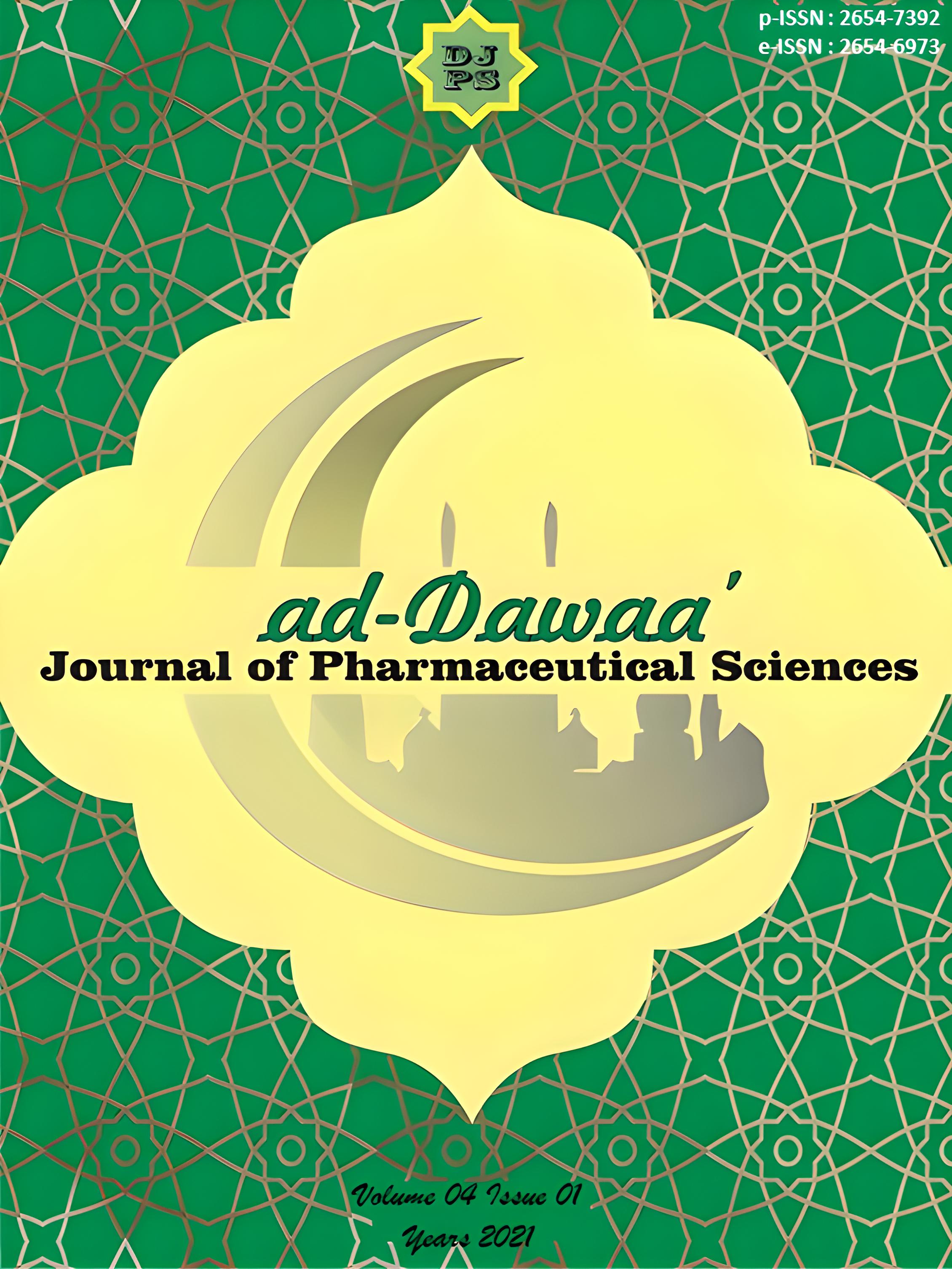Formation of Hydrochlorothiazide – Para-aminobenzoic Acid Cocrystals by Solvent Evaporation Method
Abstract
Hydrochlorothiazide is a diuretic drug used for mild to moderate hypertension were classified in Class II BSC. The purpose of this study was to explore the formation of hydrochlorothiazide-para-aminobenzoic acid cocrystal by solvent evaporation method. Cocrystals are prepared with a molar ratio of 1:0; 1:1; 1:2; and 2:1 between hydrochlorothiazide and para-aminobenzoic acid. The cocrystals were characterized by Scanning Electron Microscopy (SEM), X-ray Diffractometry (XRD), Differential Scanning Calorimetry (DSC), and Fourier Transform Infrared (FT-IR) spectrophotometer. The hydrochlorothiazide-para-aminobenzoic acid cocrystal has new crystalline peaks at 2θ of 14.904o; 15.41o; 25.553o; 26.5o; 29.844o; 31.083o indicating the formation of a new crystalline phase. The cocrystal showed the melting point at 188.57oC which is different from the initial components. The FTIR spectra of cocrystal showed the shifting of absorption peaks of groups of initial components indicating of formation of hydrochlorothiazide-para-aminobenzoic acid cocrystal through intermolecular hydrogen bond interactions between amine/sulfonamide group and carboxyl group.Downloads
References
Bunaciu, A. A., Udriştioiu, E. G., & Aboul-Enein, H. Y. (2015). X-ray diffraction: instrumentation and applications. Critical Reviews in Analytical Chemistry.
Cao, F., Amidon, G. L., Rodríguez-Hornedo, N., & Amidon, G. E. (2018). Mechanistic basis of cocrystal dissolution advantage. J Pharm Sci., 380-389.
Duggirala, N. K., Perry, M. L., Almarsson, O., & Zaworotko, M. J. (2016). Pharmaceutical cocrystals: along the path to improved medicines. Chem. Commun.
FDA. (2018). Regulatory Classification of Pharmaceutical Co-Crystals Guidance for Industry. FDA.
Gadade, D. D., & Pekamwar, S. S. (2016). Pharmaceutical Cocrystals: Regulatory and Strategic Aspects, Design and Development . Advanced Pharmaceutical Bulletin.
Gill, P., Moghadam, T. T., & Ranjbar, B. (2010). Differential Scanning Calorimetry Techniques: Applications in Biology and Nanoscience. Journal of Biomolecular Techniques, 167-193.
Guo, M., Sun, X., Chen, J., & Cai, T. (2021). Pharmaceutical cocrystals: A review of preparations, physicochemical properties and applications. Acta Pharmaceutica Sinica B.
Kaliva, M., & Vamvakaki, M. (2020). Nanomaterials characterization. In E. Payne, Polymer Science and Nanotechnology: Fundamental and Application. Matthew Deans.
Karagianni, A., Malamatari, M., & Kachrimanis, K. (2018). Pharmaceutical Cocrystals: New Solid Phase Modification Approaches for the Formulation of APIs. Pharmaceutics.
Karimi-Jafari, M., Padrela, L., Walker, G. M., & Croker, D. M. (2018). Creating Cocrystals: A Review of Pharmaceutical Cocrystal Preparation Routes and Applications. Crystal Growth & Design, 6370-6387.
Kuminek, G., Cao, F., Rocha, A. B., Cardoso, S. G., & Rodríguez-Hornedo, N. (2016). Cocrystals to facilitate delivery of poorly soluble compounds beyond-rule-of-5. Advanced Drug Delivery Reviews.
Panzade1, P., Shendarkar, G., Shaikh, S., & Rathi, P. B. (2017). Pharmaceutical Cocrystal of Piroxicam: Design, Formulation and Evaluation. Adv Pharm Bull, 399 - 408.
PubChem. (2021, June 5). https://pubchem.ncbi.nlm.nih.gov/compound/Hydrochlorothiazide. Retrieved from https://pubchem.ncbi.nlm.nih.gov/.
Saganowska, P., & Wesolowski, M. (2018). DSC as a screening tool for rapid co-crystal detection in binary mixtures of benzodiazepines with co-formers. Journal of Thermal Analysis and Calorimetry , 785–795.
Sanphui, P., & Rajput, L. (2013). Tuning solubility and stability of hydrochlorothiazide Co-crystals. Acta Crystallographica.
Sanphui, P., Devi, V. K., Clara, D., Malviya, N., Ganguly, S., & Desiraju, a. G. (2015). Cocrystals of Hydrochlorothiazide: Solubility and Diffusion/Permeability Enhancements through Drug–Coformer Interactions. Mol. Pharmaceutics, 1615–1622.
Schultheiss, N., & Newman, A. (2009). Pharmaceutical Cocrystals and Their Physicochemical Properties. Crystal Growth and Design.
Sitorus, M. (2009). Elusidasi Struktur Molekul Organik. Yogyakarta: Graha Ilmu.
Weyna, D. R., Shattock, T., Vishweshwar, P., & Zaworotko, M. J. (2009). Synthesis and Structural Characterization of Cocrystals and Pharmaceutical Cocrystals: Mechanochemistry vs Slow Evaporation from Solution. Cryst. Growth Des, 1106–1123.
Winantari, A. N., Setyawan, D., Siswodihardjo, S., & Soewandhi, S. N. (2017). COCRYSTALLIZATION ACYCLOVIR-SUCCINIC ACID USING SOLVENT EVAPORATION METHODS. Asian J Pharm Clin Res.
Górska, A., Brzezińska, R., Wirkowska-Wojdyła, M., Bryś, J., Domian, E., & Ostrowska-Ligęza, E. (2020). Application of thermal methods to analyze the properties of coffee silverskin and oil extracted from the studied roasting by-product. Applied Sciences (Switzerland), 10(24), 1–15. https://doi.org/10.3390/app10248790
Leyva-Porras, C., Cruz-Alcantar, P., Espinosa-Solís, V., Martínez-Guerra, E., Piñón-Balderrama, C. I., Martínez, I. C., & Saavedra-Leos, M. Z. (2020). Application of Differential Scanning Calorimetry (DSC) and Modulated
Differential Scanning Calorimetry (MDSC) in Food and Drug Industries. Polymers, 12(1). https://doi.org/10.3390/POLYM12010005
Rasenack, N., Mu, B. W., & Kiel, D. (2002). Crystal habit and tableting behavior of paracetamol and Ibuprofen. International Journal of Pharmaceutics, 244, 45–57.
Steinmann, W., Walter, S., Beckers, M., Seide, G., & Gries, T. (2016). Thermal Analysis of Phase Transitions and Crystallization in Polymeric Fibers. In Intech: Vol. i (Issue tourism, p. 13).
Wicaksono, Y., Setyawan, D., Siswandono, S., & Siswoyo, T. A. (2019). Preparation and Characterization of a Novel Cocrystal of Atorvastatin Calcium with Succinic Acid Coformer. Indonesian Journal of Chemistry, 19(3), 660–667. https://doi.org/10.22146/IJC.35801
Zaini, E., Afriyani, Fitriani, L., Ismed, F., Horikawa, A., & Uekusa, H. (2020). Improved solubility and dissolution rates in novel multicomponent crystals of piperine with succinic acid. Scientia Pharmaceutica, 88(2). https://doi.org/10.3390/scipharm88020021
Once an article was published in the journal, the author(s) are:
- granted to the journal right licensed under Creative Commons License Attribution that allows others to share the work with an acknowledgement of the work's authorship.
- permitted to publish their work online in third parties as it can lead to wider dissemination of the work.
- continue to be the copyright owner and allow the journal to publish the article with the CC BY-SA license
- receiving a DOI (Digital Object Identifier) of the work.


 (Sinta ID: 6166730)
(Sinta ID: 6166730)
1.png)